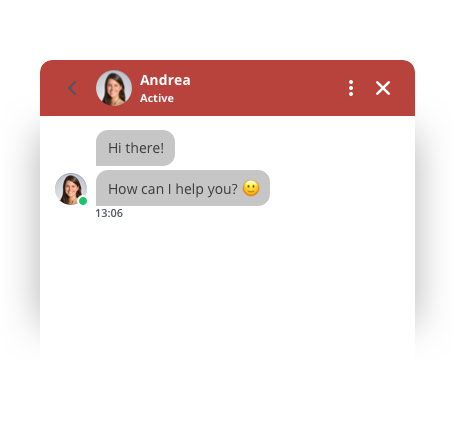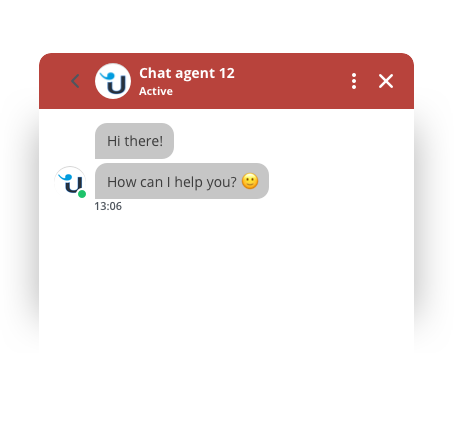
6 Tips for Personal Customer Service in the Digital Age
'Personal' is something like a holy grail for customer service. But what does personal mean in the age of digitalization?
To offer a definition, personal customer service is service delivered and tailored to an individual customer in a friendly and humane way.
It's the opposite of the treat-your-customer-like-a-number approach. But its execution isn't so straightforward when you're separated from your customers by a thick layer of cyberspace.

Some businesses try to overcome this barrier by relying on information that technology makes available to us, but this often results in 'creepy' experiences.
With Userlike , for example, agents can see the location of the web visitors they're chatting with. This can be useful to, say, assess whether the person is at all in an area that your business delivers to.
But we always recommend not to use it for unexpected remarks like, "Hi! How's the weather in Boston today?" More than offering a personal experience, it makes the customer feel like they're being tracked.
So how do you offer quality personal customer service in the digital age?
1
Know thy customer
The job of most service departments is to solve incoming problems as quickly and efficiently as possible. The downside of always being in this reactive approach is that your agents will only know your customers on a superficial level. Strictly on an FAQ basis, so to say.

But a customer request is only the tip of the iceberg. Beneath its surface lies a fully developed ecosystem of desires, needs, fears, hopes and frustrations.
Gaining a deeper understanding of your customers allows you to serve them better. Not only does it raise your empathy for their situation, it also allows you to offer possible alternatives – better solutions for the same deep desires.
Gaining a deeper understanding of our customers happens to be a current topic for us at Userlike. A few ways how we're currently tackling this:
Surveys and interviews. Customer research is one way to raise your understanding. In most companies, these are conducted by the marketing team, but it makes sense to have customer service join in on the action.
Hosted customer dinners. Another thing we do is host dinners with our customers . These rather cosy get-togethers of around forty people start out with a specific theme, but tend to quickly evolve into conversations about a wide-range of topics. Breaking bread is a great way to break the ice, and we feel these dinners truly help us to have honest, eye-to-eye dialogues with our customers.

Customer service training. The value of the insights gained through such customer research and community events remains limited when they don't seep through to your entire team. That's why it's useful to maintain customer personas and talk about them in your customer service training programs.
2
Choose your customer channels wisely
How personal an interaction feels also largely depends on the channel of contact. Nothing beats face-to-face, and from there things move down to phone, chat/messaging, email and fax.
Most highly personal channels, however, also happen to be highly inefficient – for the business as well as the customer. The prospect of some quality time spent face-to-face or on the phone is quickly spoiled by the inconvenience of having to wait in a queue.
Personal is nice, but it isn't everything. It should be balanced with convenience. Which is the reason why we believe chat and messaging are optimal channels for customer service.
Their informal and low-barrier nature make them more personal than email, while their inherent features of being text-based and instant make your support department more efficient and effective. There's a reason that messaging has been the fastest growing mode of communication in the history of mankind.

A good example of a company that rocks these channels is KLM Airlines . When you book a flight, they allow you to receive your boarding pass and flight updates via messaging apps like Facebook Messenger, WhatsApp and WeChat. When you have a question, you can simply follow up within the app.
3
Nurture customer-agent relationships
One reason we aim for personal customer service is because we are all too familiar with the horrors of the opposite: the service of anonymous, bureaucratic machines. The call-center type that gives service a bad name.
One thing that these service machines have in common is that you'll talk to a different person every time. That's frustrating. Especially when the agent doesn't have instant access to your previous conversations with the company, forcing you to repeat yourself time and time again.

Looking for better customer relationships?
Test Userlike for free and chat with your customers on your website, Facebook Messenger, and Telegram.
Read moreSo it makes sense to pay attention to the process that connects your agents with your customers. Many modern support solutions have built in such considerations.
With Userlike, for example, a feature by the name of Sticky Chat favors connections with the agent that the customer chatted with before. This allows for personal relationships to grow between customers and employees.

The fact that everything is instantly documented with chat makes transitions even with new agents easier. The previous conversations are always available. The context is always clear.
4
Show yourself
A common misperception of personal customer service is that it is all about the customer. In fact, it's just as much about the one offering the service.
Many service departments make the mistake of anonymizing their work. They sign their support emails with "Best regards, [Company name] service team" instead of "Best regards, Lucy/Bob/whoever" . A personal experience isn't possible without disclosing any personal information. It's on the company to take the first step here.
It's the reason why, at Userlike, we always recommend chat agents to enter their name and use a real profile picture.


There are, of course, limitations and challenges that some service departments have to deal with. Especially in our home country of Germany, certain work councils require anonymity for their employees. What's more, despite all the benefits that chat has to offer, its low-barrier nature makes the channel susceptible to internet trolling. Because of this, we've added some options for Operator anonymization .
But still, there are better and worse ways to deal with this issue. It's better to use a nickname than to call yourself 'Chat Agent 23', for example.
5
Write to the customer, not about the customer
When we think about service, we tend to think about direct person-to-person interactions. But an important responsibility of the customer service department is to develop the knowledge base. To write static texts.
Instead of a one-to-one, you're dealing with a one-to-many scenario. And as I noted in Write To the Customer, Not About the Customer , that's where many support reps go awry.
The secret of customer-focused mass communication is to write for an audience of millions as if it were an audience of one. This is the way to make your static support texts sounds friendly and personal.
Here are a few examples showcasing the difference between writing that talks about the customer, versus writing that talks to the customer.
| About the customer | To the customer |
|---|---|
| We have released a new feature that allows our customers to improve their support logic by guiding incoming customer requests to service agents based on their skills. | With this new feature you can improve your support logic by guiding incoming customer requests to service agents based on their skills. |
| We want our customers to know that we’ll add some new features and improvements to our system on Friday the 10th of August. This means there’ll be a downtime from 9PM - 9:30PM CEST. We recommend customers that are still chatting around that time to schedule in a coffee/watercooler break. | We’ll add some new features and improvements to your system on Friday the 10th of August. This means there’ll be a downtime from 9PM - 9:30PM CEST. Please schedule in a coffee/watercooler break if you’re still chatting around that time. |
| Userlike Customer on any one of our products will soon notice that their Dashboard includes chat statistics. Starting next week, our system will collect some key chat data which will soon be presented at the top of the dashboard. This will include a running total of your chats for the day, and a weekly summary of chats over the last 7 days. | You'll soon notice that your Dashboard includes chat statistics. Starting next week, your system will collect some key chat data which will soon be presented at the top of your dashboard. You'll find a running total of your chats for the day, and a weekly summary of your chats over the last 7 days. |
6
Bend the rules
Another hallmark of the previously mentioned bureaucratic machines is that they leave no room for edge cases; everything is regulated and standardized. And if your specific scenario hasn't been thought into the regulatory framework, well then, you're out of luck. Computer says no.

We live in a world of infinite complexity in which it's impossible to predict each and every scenario. Policies are helpful, but only as guidelines . Common sense on the frontline beats rules laid out in the general's tent. And that's why your service reps should be empowered to bend them from time to time.
An easy way to get started with this is to give each of your service agents three Get Out of Jail Free cards. Only after they've broken the policy three times will the manager take a closer look into whether the agent's sense of judgment had been sound.
Personal customer service is a powerful ideal to strive towards. If your support setup feels a bit outdated and standoffish, it's most likely a fruitful area to focus on.
If you're looking for a more personal way to reach your customers, I'd give you a self-promotional yet sincere recommendation to take a look at Userlike .
We're strong believers in chat and messaging as the ideal customer channels for the mobile and digital era. That's why we've built a solution that allows you to communicate with your customers over their favorite channels – website chat, WhatsApp, Facebook Messenger, SMS, and more – all from one place. Learn more here .

